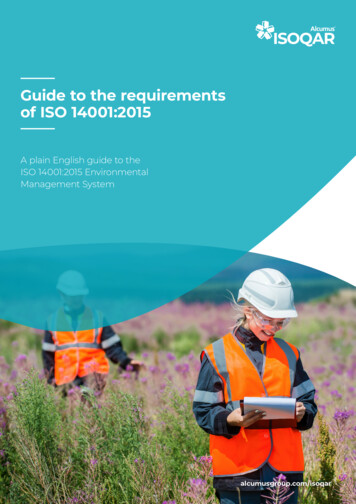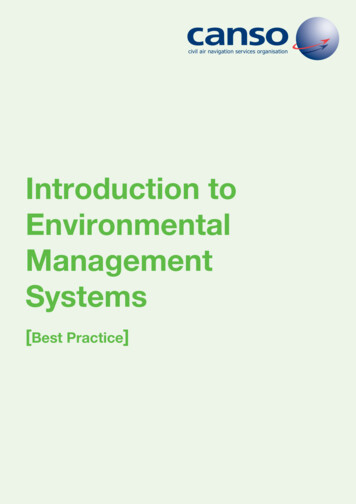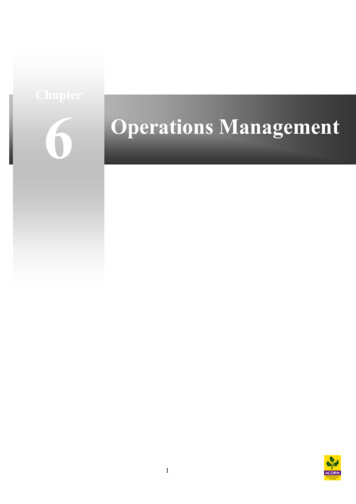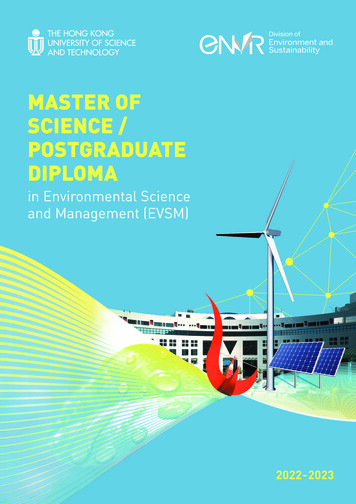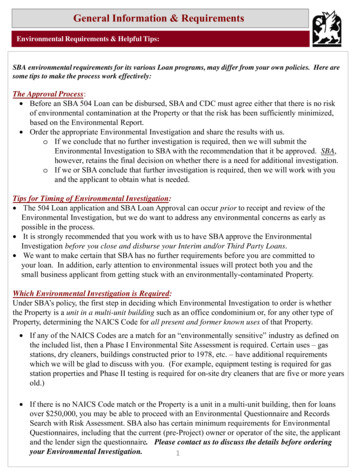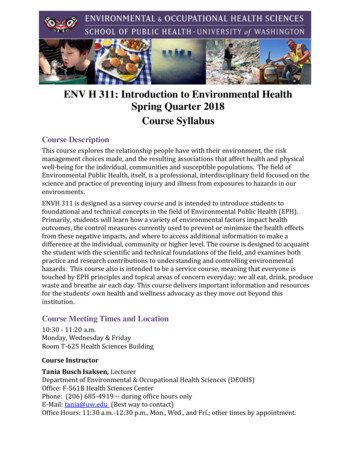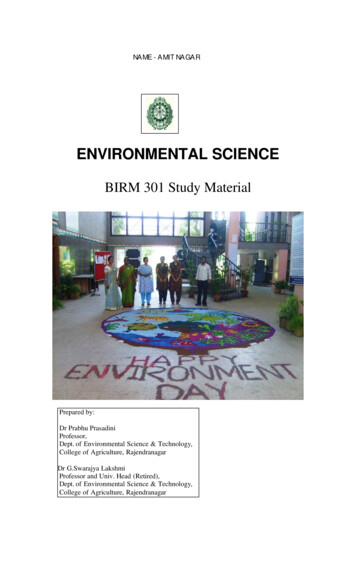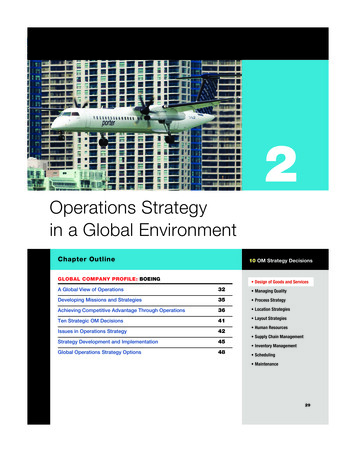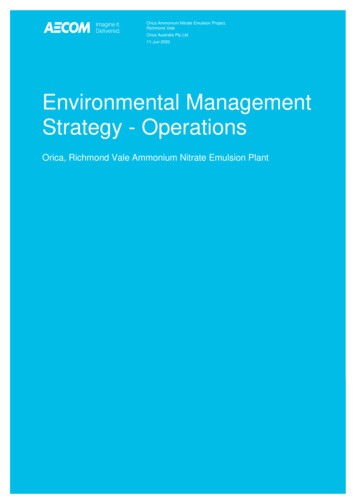
Transcription
Orica Ammonium Nitrate Emulsion Project,Richmond ValeOrica Australia Pty Ltd11-Jun-2020Environmental ManagementStrategy - OperationsOrica, Richmond Vale Ammonium Nitrate Emulsion PlantAmmonium Nitrate Emulsion Plant
AECOMOrica Ammonium Nitrate Emulsion Project, Richmond ValeEnvironmental Management Strategy - OperationsEnvironmental Management Strategy - OperationsOrica, Richmond Vale Ammonium Nitrate Emulsion PlantClient: Orica Australia Pty LtdABN: N/APrepared byAECOM Australia Pty Ltd17 Warabrook Boulevard, Warabrook NSW 2304, PO Box 73, Hunter Region MC NSW 2310, AustraliaT 61 2 4911 4900 F 61 2 4911 4999 www.aecom.comABN 20 093 846 92511-Jun-2020Job No.: 60578946AECOM in Australia and New Zealand is certified to ISO9001, ISO14001 AS/NZS4801 and OHSAS18001. AECOM Australia Pty Ltd (AECOM). All rights reserved.AECOM has prepared this document for the sole use of the Client and for a specific purpose, each as expressly stated in the document. No otherparty should rely on this document without the prior written consent of AECOM. AECOM undertakes no duty, nor accepts any responsibility, to anythird party who may rely upon or use this document. This document has been prepared based on the Client’s description of its requirements andAECOM’s experience, having regard to assumptions that AECOM can reasonably be expected to make in accordance with sound professionalprinciples. AECOM may also have relied upon information provided by the Client and other third parties to prepare this document, some of whichmay not have been verified. Subject to the above conditions, this document may be transmitted, reproduced or disseminated only in its entirety.Revision H – 11-Jun-2020Prepared for – Orica Australia Pty Ltd – ABN: N/A
AECOMOrica Ammonium Nitrate Emulsion Project, Richmond ValeEnvironmental Management Strategy - OperationsQuality InformationDocumentEnvironmental Management Strategy - OperationsRef60578946Date11-Jun-2020Prepared byAlison O'NeillReviewed byGabriel WardenburgRevision HistoryAuthorisedRevRevision 011Final for submission toDP&IC12-Jan-2012Amendments followingDP&I reviewD24-Feb-2012E01-Sep-2017Updated with MonitoringTable and InductionInformationDocument review andupdateF20-Sep-2017FinalG6-Feb-2020Document review andupdateH11-Jun-2020FinalRevision H – 11-Jun-2020Prepared for – Orica Australia Pty Ltd – ABN: N/ARuth BakerAssociate Director EnvironmentRuth BakerAssociate Director EnvironmentTroy CollieTechnical Director EnvironmentTroy CollieTechnical Director EnvironmentSimon MurphyPrincipal EnvironmentalPlannerSimon MurphyPrincipal EnvironmentalPlannerDylan TurnbullProfessional Scientist Air QualityDylan TurnbullProfessional Scientist Air QualitySignature
AECOMOrica Ammonium Nitrate Emulsion Project, Richmond ValeEnvironmental Management Strategy - OperationsThis page has been left blankintentionally.Revision H – 11-Jun-2020Prepared for – Orica Australia Pty Ltd – ABN: N/A
AECOMOrica Ammonium Nitrate Emulsion Project, Richmond ValeEnvironmental Management Strategy - OperationsTable of ContentsExecutive ronmental Policy2.0Planning2.1Environmental Aspects2.2Legal and Other Requirements2.2.1Project Approval2.2.2Protection of the Environment Operations Act 1997 (POEO Act)2.2.3Explosives Act 2003 & Explosives Regulation 20132.2.4Work Health and Safety Act 2011 and Work Health and SafetyRegulation 20172.2.5Cessnock Local Environmental Plan 20112.3Objectives and Targets3.0Implementation3.1Roles and Responsibilities3.2Training, Awareness and Competence3.3Communication3.3.1Internal Communication3.3.2External Communication3.4EMS Documentation3.5Document Control3.6Emergency Preparedness4.0Checking and Corrective Action4.1Monitoring and Evaluation4.2Non-conformance and Corrective and Preventative Action4.3Records4.4Audit4.4.1Internal Audits4.4.2Independent 1313151616191920202121212325Appendix AProject ApprovalAAppendix BEnvironmental Aspects RegisterBAppendix CExample ANE Plant InductionCAppendix DSite Induction Assessment FormDAppendix ESummary of TrainingEAppendix FSummary of NotificationsFAppendix GSummary of ReportingGAppendix HInspection ChecklistsHRevision H – 11-Jun-2020Prepared for – Orica Australia Pty Ltd – ABN: N/A
AECOMOrica Ammonium Nitrate Emulsion Project, Richmond ValeEnvironmental Management Strategy - OperationsAppendix ITable of Monitoring MeasuresIAppendix JSummary of AuditingJList of TablesTable 1Table 2Table 3Table 4Table 5Project Approval Requirements - Schedule 4, Condition 1Objectives and TargetsRoles and ResponsibilitiesEmergency ContactsRoutine InspectionsRevision H – 11-Jun-2020Prepared for – Orica Australia Pty Ltd – ABN: N/A19111719
AECOMOrica Ammonium Nitrate Emulsion Project, Richmond ValeEnvironmental Management Strategy - OperationsiExecutive SummaryThis Environmental Management Strategy (EMS) for Orica’s Ammonium Nitrate Emulsion (ANE)Facility at Richmond Vale provides an overview of environmental management at the Facility and itsassociated lands. The EMS outlines the environmental management principles and practices that willbe implemented during the ongoing operations of the ANE Facility and its associated lands. The EMShas been prepared in accordance with Condition 1, Schedule 4 of the ANE Facility Project Approval(09 0090). The EMS provides the framework for environmental management at the Facility and itsassociated lands, but does not encompass all that is required for compliance with the Approval. TheApproval is provided in Appendix A and should always be referred to as the primary compliancedocument.Environmental management at the ANE Facility reflects Orica’s environmental policy and commitmentto manage its activities with concern for people and the environment. Orica’s policy sets the frameworkfor this EMS – and together with consideration of the specific environmental aspects and potentialimpacts of the Facility and its associated lands; and recognition of applicable legislation to which Oricasubscribes - forms the basis upon which the objectives and targets within this document have beenset.The key environmental factors and aspects at the ANE Facility and its associated lands include:hazards, traffic, noise, air and odour, waste, ecology, bushfire, Aboriginal and historic heritage andwater management. The EMS identifies the potential risks to the environment related to eachenvironmental aspect on key factors, and outlines measures to mitigate potential environmentalimpacts. Mitigating measures include the implementation of the various site-specific managementplans that are in place to manage site risks, and Orica’s suite of Safety Health and Environment(SH&E) procedures that are mandatory at all sites.This EMS communicates the roles and environmental responsibilities for the implementation ofenvironmental management at the ANE Facility and its associated lands. In addition, measures tofacilitate implementation, training, communication, documentation, and emergency preparednessrequirements have been outlined along with steps for checking, undertaking corrective action, andreviewing environmental performance and management at the site.These aspects: enable the EMS to remain relevant; ensure that progress is being made toward theenvironmental objectives and targets; provide a feedback mechanism for improvements; and enablechanges in environmental legislation and site management to be reflected in the EMS.Revision H – 11-Jun-2020Prepared for – Orica Australia Pty Ltd – ABN: N/A
AECOMOrica Ammonium Nitrate Emulsion Project, Richmond ValeEnvironmental Management Strategy - OperationsThis page has been left blankintentionally.Revision H – 11-Jun-2020Prepared for – Orica Australia Pty Ltd – ABN: N/Aii
AECOM1Orica Ammonium Nitrate Emulsion Project, Richmond ValeEnvironmental Management Strategy - Operations1.0Introduction1.1BackgroundThis Environmental Management Strategy (EMS) has been prepared for Orica Australia Pty Limited(Orica) and outlines the management measures proposed to mitigate the potential environmentalimpacts that may occur during operations at Orica’s Ammonium Nitrate Emulsion Facility (ANEProduction Facility) at Richmond Vale, NSW. It covers operations at the ANE Facility undertaken inaccordance with the Project Approval (09 0090, as modified), the project approval application(Umwelt, 2009, Environmental Assessment (EA)) and subsequent modifications for the production ofup to 250,000 tonnes per annum of ANE at Orica’s Technical Centre site at Richmond Vale.Condition 1, Schedule 4 of the ANE Facility Project Approval requires Orica to prepare and implementan EMS to the satisfaction of the Director-General1 of the NSW Department of Planning, Industry andEnvironment (DPIE). The requirements of Condition 1 are shown at Table 1 below. The ProjectApproval is provided at Appendix A.Condition 7, Schedule 2 of the Project Approval allowed for the submission of documents to theDirector-General on a progressive basis. Consequently, a Construction EMS (Umwelt, 2010) wasprepared and then approved by the Director-General on 7 October 2010 prior to the commencement ofconstruction in accordance with the Project Approval. This EMS is for the operational phase of theANE Facility.This EMS provides a framework for environmental management at the ANE Facility. It is anoverarching document that outlines the environmental management principles and practices - theplans, procedures, legislation and actions - that are in place, or that will be implemented, to meetOrica’s environmental commitments during the ongoing operations of the ANE Facility and itsassociated lands, and to mitigate possible environmental impacts associated with the Facility.1.2ScopeThis EMS brings together a number of components which collectively provide a means of achievingand demonstrating commitment to managing and minimising the potential impacts associated withoperations at the ANE Facility.The EMS covers only the site considered as the ANE Facility and its associated lands (such as theaccess road and the offset area) subject to the Project Approval, and not the adjacent TechnicalCentre.This EMS has been developed in accordance with Condition 1, Schedule 4 of the Project Approval.The requirements of Condition 1 and where these requirements have been addressed in this EMS areshown at Table 1. This EMS has also been prepared in accordance with the requirements of ISO14001: 2015.Table 1Project Approval Requirements - Schedule 4, Condition 1RequirementThe Proponent shall prepare and implement an Environmental ManagementStrategy for the Project to the satisfaction of the Director-General. This strategymust be submitted to the Director-General prior to the commencement ofconstruction, and:a. Provide the strategic context for environmental management of constructionand operation of the Project;b. Identity the statutory requirements that apply to the Project;1WhereAddressed inthis EMSThis EMSSection 1.3Section 2.2The Director-General is now referred to as the Secretary, however for consistency with Project Approval requirements, thisdocument will continue to reference the Director-General.Revision H – 11-Jun-2020Prepared for – Orica Australia Pty Ltd – ABN: N/A
AECOMRequirementc.d.Describe in general how the environmental performance of the Projectwould be monitored and managed;Describe the procedures that would be implemented to:Keep the local community and relevant agencies informed about theoperation and environmental performance of the Project;Receive, handle, respond to, and record complaints;WhereAddressed inthis EMSSection 2.1 &Section 4.1Section 3.3.2.1Section 3.3.2.2Section 3.3.1-Resolve any disputes that may arise in relation to operations at theProject;Response to any non-compliance;-Manage cumulative impacts;Section 2.1-Respond to emergencies; andSection 3.6-e.2Orica Ammonium Nitrate Emulsion Project, Richmond ValeEnvironmental Management Strategy - OperationsDescribe the role, responsibility, authority and accountability of all the keypersonnel involved in environmental management of the Project.Section 4.2Section 3.1The ANE Facility operates from 4.00am – 9.30pm Monday - Friday and requires three employees ondiscrete shifts. The facilities, activities, products and services at the ANE Facility considered in thisEMS, include:·Arrival of raw materials (Ammonium Nitrate Solution (ANS), palm olien, yubase 3 and diesel oil,thiourea, urea, acetic acid, caustic soda, solid ammonium nitrate, potable water and processwater) at the ANE Facility via road transport;·Truck weighing, loading and unloading facilities;·Dedicated storage facilities for raw materials;·A manufacturing plant for the production of up to a maximum of 250,000 tonnes per annum ofANE;·Emulsion storage;·Oxidiser solution batching;·Companion (ammonium nitrate) solution manufacture and storage;·Heat exchanger and cooling tower;·Loading of emulsion, and companion solution produced at the ANE Facility onto road transport fordistribution;·An office facility, storage shed, ANE plant control room, electrical switch room, and plant qualitycontrol laboratory;·Security fencing and maintenance of perimeter fire-breaks;·Rainwater harvesting, storage and reuse;·Firewater storage; and·Surface water / firewater controls.The ANE Facility has the capability to produce up to 250,000 tonnes of ANE per annum. Average totaldaily heavy vehicle movements associated with the ANE plant at full production is expected to beapproximately 100 (i.e. 50 into the site and 50 out of the site).The ANE Facility Manager has overall responsibility for this EMS and supporting documentation.Revision H – 11-Jun-2020Prepared for – Orica Australia Pty Ltd – ABN: N/A
AECOM1.3Orica Ammonium Nitrate Emulsion Project, Richmond ValeEnvironmental Management Strategy - Operations3Environmental PolicyOrica’s organisational Safety, Health and Environment (SH&E) Policy sets the framework for this EMS.Together with consideration of the site-specific environmental aspects and legislation applicable to theANE Facility and its associated lands, the Policy forms the basis upon which the objectives and targetswithin this document have been set. Orica’s SH&E Policy has been defined and endorsed by Orica’ssenior management and it is a requirement that the Policy is known and understood by people at alllevels of the organisation.Orica’s SH&E2 Policy includes the following aspiration and actions:OUR SAFETY, HEALTH AND ENVIRONMENT ASPIRATIONTo conduct our business in a way that causes no harm to the health and safety of our people, ourcustomers or the community, and minimises our impact on the environment.OUR SAFETY, HEALTH AND ENVIRONMENT ACTIONSWe will achieve our Safety, Health and Environment aspiration by: always being mindful of risk;ensuring our people are capable and empowered; and focusing on always improving.Always mindful of risk·We implement rigorous Standards and Procedures to ensure our people succeed in their work.·We seek to eliminate or minimise our Safety, Health and Environment risk, leveraging thehierarchy of controls.·We reduce our environmental footprint through minimising waste and fresh water use, minimisingpollution and efficiently using resources.·We verify and monitor how our risks are being managed at the frontline and comply with allrelevant Safety, Health and Environment legislation, internal policies and standards.Capable & empowered·Our people are engaged, understand their responsibilities and have the resources, training,competency and systems to successfully execute their tasks.·Our people have all Safety, Health and Environment information that is relevant to their work andtheir wellbeing.·We only proceed with work when we know we can do it safely, and we are empowered to stopwork if unsafe.Always improving·We create and maximise opportunities to learn and improve.·We investigate and manage Safety, Health and Environment incidents and implement actions toprevent recurrence in order to drive continuous improvement.·We monitor, report and drive continual improvement of our Safety, Health and Environmentperformance including the setting of objectives, targets and KPIs.Orica’s approach to site SH&E management is based on thorough identification of hazards andassessment and control of risks through:·Management ownership and responsibility for SH&E performance which is active and visible at alllevels;·Clear SH&E expectations and objectives for managers and employees of both Orica andcontractors;2Orica, March 2017, SH&E Policy, -Governance-Policies.Revision H – 11-Jun-2020Prepared for – Orica Australia Pty Ltd – ABN: N/A
AECOMOrica Ammonium Nitrate Emulsion Project, Richmond ValeEnvironmental Management Strategy - Operations·Involvement of all project participants including Orica and Contractors in the SH&E managementprogram;·Comprehensive SH&E Procedures and instructions which:··-Comply with the Orica SH&E Management System and regulatory requirements, and-Are understood by all personnel working on the Project.Programs to help people anticipate potential injuries and incidents and to encourage personalaction to minimise risk, such as:-Job Safety and Environment Risk Analysis (JSERA) Program;-Job Start;-Periodic Toolbox Talk Meetings;-Behavioural Safety Program;-Monthly Safety Meetings; and-Incident Investigation Process.Project SH&E standards which are not compromised by conflicts in schedule, cost or qualityobjectives.Revision H – 11-Jun-2020Prepared for – Orica Australia Pty Ltd – ABN: N/A4
AECOMOrica Ammonium Nitrate Emulsion Project, Richmond ValeEnvironmental Management Strategy - Operations2.05Planning2.1Environmental AspectsThe potential environmental aspects and impacts of the planned operational activities at the ANEFacility are presented in the Environmental Aspects Register at Appendix B. The aspects weredetermined from the EA, site inspection, and discussion with Orica staff.The key environmental aspects identified were:·Hazard and risk;·Traffic;·Noise;·Air and odour;·Waste;·Ecology;·Bushfire;·Aboriginal and historic heritage, and·Water management.The Register of Environmental Aspects identifies the potential risks to the environment related to eachof the environmental aspects and applies a ranking system in order to allow priorities for action to beestablished ranging from “high” risk to “low” risk. The matrices to determine risk are also provided atAppendix B.The most significant potential hazard at the ANE Facility relates to potential critical incidents at the site– such as a spill, explosion or fire. To reduce the possibility of any such hazard, the site has beendesigned, and is managed to reduce the potential for possible incidents; and controls are in place toprotect the safety and health of workers, and to protect the environment.The measures to mitigate identified potential environmental impacts are included in the Register.Mitigating measures include implementation of the various site-specific management plans that are inplace to manage site risks, and Orica’s SH&E Procedures that are mandatory at all sites.The Register will be reviewed every two years, and changes to the identification of aspects, theassessment of risk, and the identification of control measures to reduce the risk will be implementedas required.Orica Procedure “GS.18 Risk Management” defines requirements for ongoing systematicidentification, assessment and management of SH&E risks associated with Orica’s activities, productsand services. The procedure includes processes for:·Identification of potential hazards events and environmental aspects;·Assessment of the level of risk from hazardous events and environmental aspects;·Identification of control measures to reduce the risk;·Identification and communication of the “basis of safety” for the facilities;·Selection of the critical control measures which warrant and require ongoing management toassure their integrity;·Review of hazards, risk, and control measures:-Prior to the introduction of changes;-When new information regarding hazards and risk becomes available, and-At defined intervals.Revision H – 11-Jun-2020Prepared for – Orica Australia Pty Ltd – ABN: N/A
AECOMOrica Ammonium Nitrate Emulsion Project, Richmond ValeEnvironmental Management Strategy - Operations6In addition Orica Group Procedure “SHES Assurance” describes the requirements for the periodicconduct of “Significant Risk Audits” to verify the suitability and effectiveness of the measures in placeto manage high priority significant risks. In association with these procedures, the risk managementprocedure “SHES Risk Management for Operating Sites” describes the requirements for theassessment and control of hazards at existing sites via “Periodic Hazard Studies”.2.2Legal and Other RequirementsThis section identifies the environmental legislative requirements to which Orica subscribes at the ANEFacility (as at February 2020). It lists legislation applicable to the site, under which Orica holds permitsor licences, or adheres to criteria that must be in place for current operations.Should the scope of current operations change, or if a development application is to be lodged foralterations or extensions to the ANE Facility or its associated lands, applicable legislation andenvironmental planning instruments should be investigated, and this section should be updated, toensure currency.2.2.1Project ApprovalThe NSW Environmental Planning and Assessment Act 1979 (EP&A Act) and the EnvironmentalPlanning and Assessment Regulation 2000 (EP&A Regulation) provide the framework forenvironmental planning in NSW. Under Part 3A of the EP&A Act (now repealed), Project Approval forthe ANE Facility was granted by the Minister for Planning on 26 July 2010. While Part 3A of the EP&AAct was repealed in 2011, transitional arrangements (also now repealed) were previously set out inSchedule 6A which provided that Part 3A continued to apply to approved Part 3A projects, includingmodifications to Project Approvals under section 75W of the EP&A Act.Two modifications to the Project Approval were approved under section 75W of the EP&A Act,including MP 09 0090 MOD 1 (approved 9 November 2012) for the construction of a storage shedand a 2 megalitre water tank, and MP 09 0090 MOD 2 (approved 4 July 2016) for the installation of aheat exchanger and cooling tower.On 1 March 2018, the transitional Part 3A modification provisions were removed from the EP&A Actand these former Part 3A provisions no longer apply. Therefore, future modifications to the ProjectApproval MP 09 0090 would be assessed under Part 4 of the EP&A Act.The Project Approval (as modified), the EA, the Statement of Commitments in the EA, theenvironmental assessments (and associated consent conditions) accompanying the modificationapplications, and the other plans required under the Project Approval, act as the guiding documentsfor the development of this EMS and for environmental planning compliance at the site.In addition to Condition 1, Schedule 4 of the Project Approval, which requires preparation andimplementation of an EMS, there are several conditions relating to operations at the site which arereferenced in this EMS. In accordance with the conditions of approval, during operations Orica shall:·Implement all reasonable and feasible measures to prevent and/or minimise any harm to theenvironment that may result from the construction and/or operation of the Project;·Ensure that all plant and equipment used on the Project Site is maintained in a proper andefficient condition; and operated in a proper and efficient manner;·Have in place an Emergency Plan and a Safety Management System;·Have in place a Road Transport Protocol for heavy vehicles including a Traffic Management Plan,and a Driver Code of Conduct;·Ensure that noise generated from the project does not exceed 35 dB(A) LAeq(15 minute) at the nearestresidential receptor at any time;·Implement the recommendations of the “Bushfire Threat Assessment” included in the EA andmeasures outlined in the Submissions Report;·Comply with Section 120 of the Protection of the Environment Operations Act 1997;Revision H – 11-Jun-2020Prepared for – Orica Australia Pty Ltd – ABN: N/A
AECOMOrica Ammonium Nitrate Emulsion Project, Richmond ValeEnvironmental Management Strategy - Operations7·Ensure that all chemicals, fuels and oils associated with the Project are stored in appropriatelybunded areas, with impervious flooring and sufficient capacity to contain 110% of the largestcontainer stored within the bund;·Have in place a Soil and Water Management Plan, including a Stormwater Management Plan andan Erosion and Sediment Control Plan;·Ensure that lighting is mounted, screened and directed in such a manner that it does not create anuisance to surrounding properties or the public road network; and·Ensure that all waste generated by the Project during construction and operation is classified inaccordance with the Environmental Protection Authority (EPA) Waste Classification Guidelines2014, and if required, disposed of to a facility via a transporter that may lawfully accept the waste.Appendix B lists the appropriate controls, safeguards and compliance actions to ensure compliancewith these conditions.2.2.2Protection of the Environment Operations Act 1997 (POEO Act)Under the POEO Act, Orica holds an Environmental Protection Licence (EPL) 4121 for the TechnicalCentre. As such all works and activities at the ANE Facility must be carried out in accordance with theEPL.EPL 4121 authorises the carrying out of the following scheduled activities at the scales specified forthe Orica Technical Centre:·Chemical production-Dangerous goods production (capacity to produce greater than 25000 T per year); and-Explosives production (capacity to produce 0 - 2000 T per year).Specifically, condition L6.1 of the licence notes that the licensee shall not produce more than 250,000tonnes per annum of Ammonium Nitrate Emulsion (ANE) at the premises.The EPL also applies to the ancillary activity relating to the Sewage Treatment System at theTechnical Centre. Condition L2.1 allows up to 16,800 litres per day of treated effluent to be applied tothe utilisation area, which comprises one hectare of office area lawns and gardens .Condition L3 defines the wastes that may be received at the premises and specifies the waste limitsthat apply. Only 8 tonnes of each of the waste types are permitted on the premises at any one timeand must be stored in accordance with any SafeWork specifications. Permitted wastes are defined as:·Off-specification explosives and ordinance originally manufactured by the licensee – offspecification products returned to the licensee for research and development, testing and/orreprocessing;·Waste: all other types – Off-specification products or explosive materials sent to the licensee forresearch and development, testing and/or reprocessing.Condition P1.3, L4 and M4 of the EPL also details specific conditions relating to the noise limits forproduction:·Noise generated from the premises must not exceed 35dB(A) LAeq,(15 minutes) at receptors R1-R21referred to in “Environmental Assessment, Proposed Ammonium Nitrate Emulsion ProductionFacility and Continued Operation of Orica Mining Services Technical Centre, Richmond Vale,NSW” 2009, at any time during construction and operations; and·Noise limits do not apply under certain meteorological conditions;·Noise monitoring must be undertaken following the receipt of a noise complaint if required by theEPA, and noise monitoring equipment must be located as specified.In accordance with EPL 4121 Orica shall:·Maintain in a proper and efficient condition, and operate in a proper and efficient manner, plantand equipment installed at, or used at, the site;Revision H – 11-Jun-2020Prepared for – Orica Australia Pty Ltd – ABN: N/A
AECOMOrica Ammonium Nitrate Emulsion Project, Richmond ValeEnvironmental Management Strategy - Operations·Ensure that the quantity of effluent/solids applied to the utilisation area does not exceed thecapacity of the area to effectively utilise the effluent/ solids;·Monitor concentration of pollutants discharged to the utilisation area;·Ensure that all licensed activities are carried out in a competent manner including the:-Processing, handling, movement and storage of materials and substances used to carry outthe activity, and-The treatment, storage, processing, reprocessing, transport, and disposal of wastegenerated by the activity.8·Ensure that all chemicals, fuels and oils stored at the premises are contained within appropriatelydesigned bunded areas complying with Australian Standards, having impervious flooring, and aminimum capacity of 110% of the largest container stored therein;·Not cause or permit the emission of offensive odour beyond the boundary of the site inaccordance with section 129 of the POEO Act;·Maintain the premises and undertake operations in a manner that minimises or prevents theemission of dust from the premises;·Ensure trucks entering and leaving the premises have their loads covered at all times exceptduring loading and unloading;·Treat all sewage inflows to the sewage treatment plant with a minimum ultraviolet disinfection rateof 30 milliwatts-second per square metre prior to discharge;·Ensure spray from effluent application does not drift beyond the boundary;·Undertake effluent application in a manner that does not cause surface runoff;·Deny public access to the effluent utilisation area during effluent application and until the effluentapplication area has dried;·Install adequate notices warning the public not to drink or otherwise use the treated effluent onthe site;·Ensure the wastewater management system is inspected and assessed by a wastewatertechnician each quarter a
Environmental Management Strategy - Operations Revision H – 11-Jun-2020 Prepared for – Orica Australia Pty Ltd – ABN: N/A AECOM 1 1.0 Introduction 1.1 Background This Environmental Management Strategy (EMS) has been prepared for Orica Australia Pty Limited (Orica) and outlines the m


